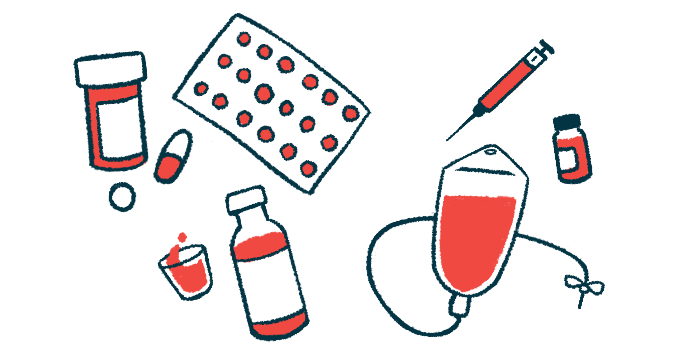HAE patients can see early signs of attacks, need for prompt treatment
Patients surveyed prefer oral vs injectable treatments, given similar efficacy

People with hereditary angioedema (HAE) are able to recognize early signs of swelling attacks and the need to get prompt on-demand treatment to manage them, new research highlights.
Findings were presented by KalVista Pharmaceuticals in a series of posters at the recent U.S. Hereditary Angioedema Association (HAEA) National Summit in Orlando, Florida. KalVista is currently developing an experimental oral medication, called sebetralstat (formerly known as KVD900), as an on-demand treatment for HAE swelling attacks. The therapy is now in Phase 3 clinical testing.
“The data presented at HAEA adds to the growing evidence that there remains an important unmet need for both people using only on-demand therapies as well as those on long-term prophylaxis [preventive treatment],” Andrew Crockett, KalVista’s CEO, said in a company press release.
“By offering the first oral, on-demand medication in sebetralstat, we intend to address this gap in treatment as well as enable future physician/patient discussions about new options that may allow people with HAE to live better lives,” Crockett said.
107 HAE patients surveyed about their experiences with swelling attacks
Researchers at KalVista conducted a survey of people with HAE to assess their experiences with swelling attacks and their perceptions of on-demand treatment.
The survey was answered by 107 patients, ranging in age from 16 to 83 years. All of them used on-demand therapies as needed to control swelling attacks, and about half (50.5%) were on prophylactic therapies. More than three-quarters (78.5%) of the patients used the subcutaneous (under-the-skin) injection therapy icatibant, marketed as Firazyr and generics, as on-demand treatment.
In one poster, researchers presented survey data highlighting that people with HAE are able to recognize the early signs of a swelling attack. That poster was titled “In Their Own Words – Patient Descriptions of the Earliest Recognition of HAE Attack Onset.”
Patients commonly described feelings of tightness, pressure, or swelling as a first indicator of an attack. Many also reported feeling pain, itchiness, or tingling, as well as fatigue or feeling generally unwell or “off.”
Collectively, these findings show that “people living with HAE are able to consistently recognize and describe the initial onset of an HAE attack,” the researchers wrote, though they noted that “descriptions used by people living with HAE to describe attack onset are variable and highly individualized.”
The team added that these findings “may help to inform future treatment discussions and may enhance aspects of the physician/patient dialogue.”
It’s important that I recover because attacks delay my day-to-day activities like going to work, my social life, my time with my family. Attacks bring my spirits down. It hurts me to see my loved ones observing my pain and suffering.
Most patients felt their attacks were more severe with delayed treatment
In a separate poster, titled “Recognizing the Importance of Early On-Demand Treatment in the HAE Attack Journey,” researchers used data from the same survey to assess patients’ attitudes toward early on-demand treatment of swelling attacks.
Results showed that the vast majority of patients felt their attacks were more severe when they delayed on-demand treatment (74.8%), and that recovery from an attack took longer when on-demand treatment was delayed (80.4%). Nearly all (95.3%) of the patients said their anxiety noticeably decreased once treatment kicked in and swelling started to resolve.
For most patients (80%), a desire to return to normal life was the main motivator in wanting to quickly deal with swelling attacks.
“Treating an attack early allows me to return to normal activities right after treatment,” one patient said. “I may have slight residual swelling for several more hours, but that never hampers my daily activities.”
Another patient commented: “It’s important that I recover because attacks delay my day-to-day activities like going to work, my social life, my time with my family. Attacks bring my spirits down. It hurts me to see my loved ones observing my pain and suffering.”
20 HAE patients surveyed about treatment preferences
In a third poster, scientists conducted interviews with 20 HAE patients — 10 adolescents and 10 adults — to better understand their attitudes about on-demand treatment. That poster was titled “Preferences of People with Hereditary Angioedema for On-Demand Treatment: A US-Based Qualitative Study.”
Results showed that most patients liked that their current on-demand therapy was effective at controlling swelling attacks. However, a sizeable number of patients reported feeling less than happy about having to deal with the hassle and pain of injections.
Patients were also asked to choose between two hypothetical on-demand treatment scenarios: to self-administer an injectable medication at home or to take a pill.
When the two hypothetical therapies were equivalent in terms of safety and efficacy, patients universally preferred the pill, for reasons including convenience and less pain. However, when the hypothetical injection was notably safer or more effective, 85% of patients chose the injection over the pill.
“Self-administered injection was only preferred over oral on-demand treatment if it offered substantially better efficacy over oral treatment, and only if the oral treatment had substantively worse tolerability/side-effect risk than observed in available clinical studies,” the researchers wrote.
Crockett said “people living with HAE clearly recognize the start of their HAE attacks and understand that they should treat them as early as possible to enable return to normal activities, yet often delay or deny themselves treatment due to the many challenges associated with injection or infusions.”








